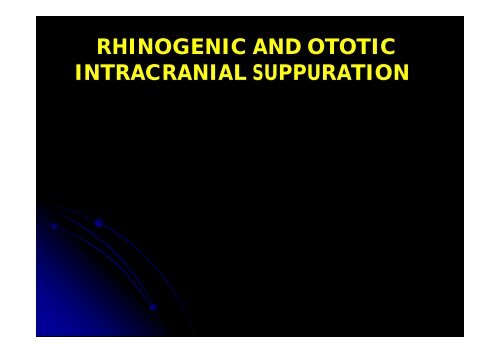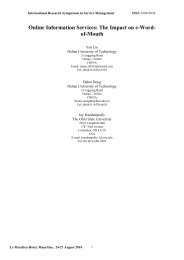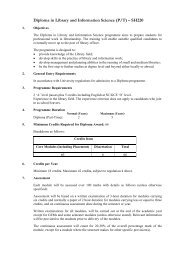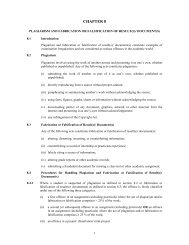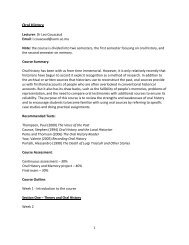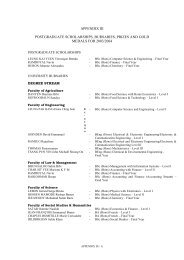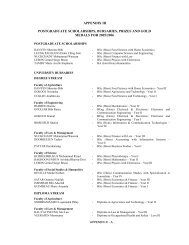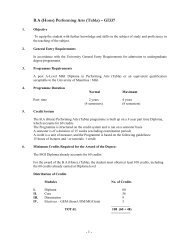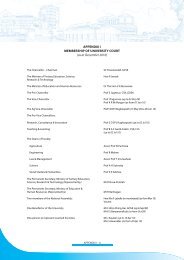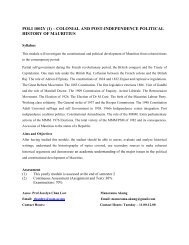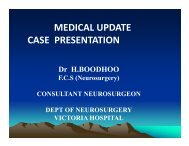RHINOGENIC AND OTOTIC INTRACRANIAL SUPPURATION
RHINOGENIC AND OTOTIC INTRACRANIAL SUPPURATION
RHINOGENIC AND OTOTIC INTRACRANIAL SUPPURATION
You also want an ePaper? Increase the reach of your titles
YUMPU automatically turns print PDFs into web optimized ePapers that Google loves.
<strong>RHINOGENIC</strong> <strong>AND</strong> <strong>OTOTIC</strong><br />
<strong>INTRACRANIAL</strong> <strong>SUPPURATION</strong><br />
Dr H. BOODHOO<br />
F.C.S<br />
Consultant Neurosurgeon
CASE PRESENTATION
Age: 8 yrs<br />
Sex: male<br />
PATIENT PROFILE<br />
Address: Vacoas<br />
Mother: selfemployed<br />
Father: carpenter<br />
Sibling: 5yr a&w
HISTORY<br />
Referred from private clinic on 24/06/08<br />
Initially attended JH with:<br />
Fever<br />
Vomiting<br />
Abdominal pain<br />
No headache<br />
No fits<br />
No visual complaints<br />
Duration: 3 days
Admitted<br />
? Early GE<br />
HISTORY (cont.)<br />
Mother signed DAMA<br />
Admitted in Clinic<br />
Persisting complaints<br />
Next day: neck stiffness<br />
Intravenous antibiotic therapy<br />
Investigation: ↑↑ WCC<br />
Special investigation: CT Brain ±Contrast
Pansinusitis<br />
CT BRAIN<br />
Right frontal brain abscess<br />
Right fronto temporo parietal subdural<br />
empyema<br />
Referred urgently to neurosurgical unit,<br />
Victoria Hospital
PAST HISTORY<br />
h/o fall from stairs 3yrs back- had a<br />
lacerated wound on right forehead<br />
PMH<br />
PSH<br />
Drug history<br />
Allergic history<br />
Immunisation history<br />
Social history
On Examination<br />
General physical examination<br />
Sick looking<br />
Extremely thin<br />
Unusually quiet<br />
Wt. 16kgs<br />
P: 92/min T/°C: 37.6 RR: 14/min<br />
No pallor, no jaundice<br />
No clubbing<br />
No lymphadenopathy<br />
ENT: nasal secretions ++ rt.>lt.
On Examination (cont)<br />
Systemic examination<br />
CVS: Normal HS, no murmur<br />
RS: chest was clear, trachea centrally<br />
located, no adventitious sounds<br />
Abdomen: scaphoid, no organomegaly, mild<br />
RUQ tenderness<br />
Genitals: normal
On Examination (cont)<br />
CNS examination<br />
GCS: E 4M 5V 6<br />
Higher mental functions<br />
Mild neck stiffness<br />
No cerebellar signs<br />
No photophobia<br />
Moving all limbs<br />
Fundoscopy: no papilledema<br />
Cranial nerve examination: normal
INVESTIGATION<br />
Hematological: ↑↑ WCC<br />
Biochemistry: normal<br />
LFT: normal<br />
Special investigation- CT BRAIN ±C
Admitted<br />
MANAGEMENT<br />
Continued i.v. antibiotic therapy<br />
i.v. fluid therapy<br />
Conditioned stabilised<br />
Urgent referral to E.N.T Hospitaladmitted<br />
BAWO- Pus +++ right maxillary sinus<br />
Back to VH next day
MANAGEMENT (cont)<br />
25/06/08: Cranial surgery<br />
1. Right small frontal craniotomy for<br />
drainage of brain abscess<br />
2. Wide temporoparietal craniotomy for<br />
evacuation of subdural empyema<br />
Nursed in ICU<br />
I.v antibiotics/ i.v phenytoin
POST-OP<br />
Marked improvement in clinical condition<br />
Uncomplicated recovery phase<br />
Lab culture report: sterile<br />
Drains removed after 48 hrs<br />
Referred to nutritionist- high protein diet<br />
Progress CT brain showed good evacuation of<br />
brain abscess & empyema, no features of infarct<br />
or ↑ ICP<br />
Continued on i.v antibiotics for two weeks
Still having RUQ pain<br />
Ultrasound abdomen<br />
1. Gall bladder filled with<br />
calculi<br />
2. Small rt. Renal calculus<br />
Surgical opinion<br />
Pediatric opinion<br />
Still under investigation<br />
Review with surgeon<br />
POST-OP
With Neurosurgeon<br />
Oral antibiotics<br />
Oral AED<br />
Repeat CT of brain<br />
REVIEW
Thank you!!
4/18/2011<br />
16 years Male<br />
Patient Profile 2<br />
Comores Island<br />
c/o Chronic discharge Left ear<br />
Headache, confusion, fever<br />
GCS10/15 (E3M5V2)<br />
Spastic, neck stiffness
Emergency combined surgical<br />
treatment<br />
Radical mastoidectomy and<br />
posterior fossa craniectomy
4/18/2011 30
4/18/2011 31
2 cm x 1 cm<br />
CAVERNOUS SINUS<br />
Located on each of sella turcica and<br />
body of sphenoid bone<br />
Superior orbital fissure to apex of<br />
petrous bone
ANATOMY<br />
Facial veins connect with the cavernous<br />
sinus via ophthalmic veins<br />
Thrombophlebitis of cavernous sinus can<br />
spread to superior and inferior petrosal<br />
sinuses
ANATOMY<br />
Posterior intercavernous sinus superior and<br />
inferior petrosal sinuses<br />
Receive blood from superior and inferior<br />
ophthalmic vein<br />
They drain posteriorly and inferiorly through the<br />
superior and inferior petrosal sinuses and<br />
pterygoid plexuses
Infections of<br />
SPREAD<br />
Face, nose, orbit, tonsils, soft palate, pharynx,<br />
air sinuses, middle ear and mastoid can all<br />
spread to cavernous sinuses<br />
Sphenoid and posterior ethmoid sinuses<br />
Jaw –tooth extraction, maxillary surgery via<br />
(pterygoid plexuses)
Fever<br />
SYMPTOMS & SIGNS<br />
Ptosis/chemosis<br />
Oculomotor palsies (III, IV, VI)<br />
Contralateral hemiparesis (thrombosis ICA)
CT brain<br />
Irregular filling defect<br />
Convex bulging of the lateral wall<br />
Dilatation of superior opthalmic vein<br />
Thickening of extra ocular muscles and<br />
periorbital edema
Antibiotics (high doses)<br />
TREATMENT<br />
(Staph aureus, Strep pneumonia, Haemophilus<br />
influenzae<br />
Anticoagulant (no evidence of cortical venous<br />
infarct)<br />
Surgery- sphenoid sinus sepsis<br />
100 % mortality to 30 %
<strong>RHINOGENIC</strong><br />
<strong>INTRACRANIAL</strong> SEPSIS
Leading neurological manifestation<br />
Fever 96%<br />
Seizures 70%<br />
Neurological signs 58%
Epidemiology<br />
Most common in males<br />
Seasonal variation
Etiology<br />
Spread<br />
Direct- Erosion of Tegmen tympani<br />
Erosion of posterior wall of frontal sinus<br />
Retrograde septic thrombophlebitis<br />
Facial or scalp infection<br />
Dental sepsis<br />
Meningitis<br />
Cranial surgery e.g. depressed fracture<br />
Infection at distant sites
Etiology<br />
Otorhinolaryngeal infection- 40-70 %<br />
Paranasal sinusitis<br />
Otitis media<br />
Mastoiditis<br />
Cranial trauma- 6-30%
Predisposing factors<br />
Diabetes Mellitus<br />
Alcoholism<br />
Chest infection<br />
Sepsis<br />
HIV<br />
Immunodepression- steroids, cytotoxic<br />
drugs<br />
Poor nutrition, poor hygiene, delayed<br />
treatment
“Frequent use of broad<br />
spectrum antibiotics may<br />
contribute to subdural<br />
empyema”
Most common pathogens<br />
Strep pneumoniae- 16%<br />
Group B strep- 13%<br />
H. Influenzae- 13%<br />
Salmonella spp- 13%<br />
E. coli- 10%<br />
Pseudomonas aeruginosa- 10%
Pathogens<br />
Pus- sterile in 40%<br />
Use of broad spectrum antibiotics<br />
NTSO- non typhoidal salmonella<br />
organisms have been reported in the<br />
setting of advanced AIDS infection
Diagnosis<br />
Difficult to clinically differentiate between<br />
meningitis and SDE<br />
Diagnosis is based on strong clinical<br />
suspicion<br />
Triad of- fever<br />
sinusitis<br />
neurological deficit
Investigation<br />
Infants: brain sonography<br />
CT Bain with contrast, brain and paranasal<br />
sinuses, posterior fossa cuts
Investigation<br />
CT Brain (contrast)<br />
Thin rim of fluid, slightly hyperdense to<br />
CSF with surrounding enhancement,<br />
adjacent disproportionate cortical edema<br />
and effacement of cortical sulci<br />
Cranial ultrasound can substitute CT in<br />
infants<br />
LP must be avoided
Management<br />
Timing of surgery<br />
Simultaneous neurosurgical and ENT<br />
intervention<br />
SDE requires surgical evacuation of<br />
infected material, irrespective of its volume
Management<br />
Craniotomy was determined to be the<br />
surgical procedure of choice in SDE<br />
Allows complete evacuation<br />
Decompression of cerebral hemisphere
Prognosis<br />
Early diagnosis and treatment<br />
High degree of suspicion<br />
“Prolonged fever, seizures, neurological<br />
signs”
Age<br />
GCS<br />
Prognostic factors<br />
Timing/ aggressiveness of treatment<br />
Progression of disease
Outcome<br />
Mortality- 100% before advent of<br />
antibiotics & CT<br />
Decreased to 40% after CT Scan<br />
10-12% presently
Intracranial subdural empyema is a<br />
neurosurgical emergency<br />
It is rapidly fatal if not recognised early<br />
and managed promptly
Early drainage, simultaneous<br />
eradication of the primary source of<br />
sepsis and intravenous administration<br />
of high doses of appropriate<br />
antibiotics agents represents the<br />
mainstay of treatment
1. Direct spread<br />
Spread<br />
Erosion through the postwall of<br />
frontal<br />
sinus which has one-half the<br />
thickness of<br />
the anterior wall<br />
2. Indirect mechanisms<br />
Retrograde thrombophlebitis<br />
i l i
Lumbar Puncture L.P<br />
L.P performed in the presence of clinical<br />
features of raised ICP and focal<br />
neurological signs are extremely<br />
dangerous
Disparity between CT imaging and<br />
clinical findings<br />
-integrity of arachnoid membraneprevent<br />
spread<br />
-improve blood brain barrier<br />
-Wide cerebral decomposition via a wide<br />
craniotomy
DIAGNOSIS<br />
Infective sinustis<br />
Periorbital swelling<br />
Purulent dural discharge<br />
Positive Neurosurgical signs<br />
MUST HAVE CT SCAN BRAIN<br />
& PNS
Role of Non Operative<br />
treatment<br />
Fully concious patient, with small EDE (no<br />
radiological mass effect) with no<br />
neurological deficit, signs of clinical<br />
improvement (temperature ; ESR ;<br />
WCC<br />
May be treated with intravenous antibiotics<br />
and prophylatic antiepileptic provided the<br />
primary source of sepsis has been<br />
surgically eradicated
Unlike SDE, EDE is a disease that<br />
should be managed without<br />
morbidity or death
INFRATENTORIAL EMPYEMA<br />
Rare, highly lethal form of intracranial<br />
suppuration<br />
Lumbar puncture<br />
Cereballar abcess<br />
Hydrocephalus<br />
Extension of pus to cerebello pontine angle
INFRATENTORIAL EMPYEMA<br />
TREATMENT<br />
Early aggressive surgical drainage and<br />
decompression of the cerebellum by a<br />
wide posterior fossa craniectomy ,<br />
eradication of the primary source of<br />
infection (usually mastoiditis) treatment of<br />
concomittant hydrocephalus high dose<br />
intravenous antibiotics
THANK YOU


